2004 ISUZU TF SERIES switch
[x] Cancel search: switchPage 3661 of 4264
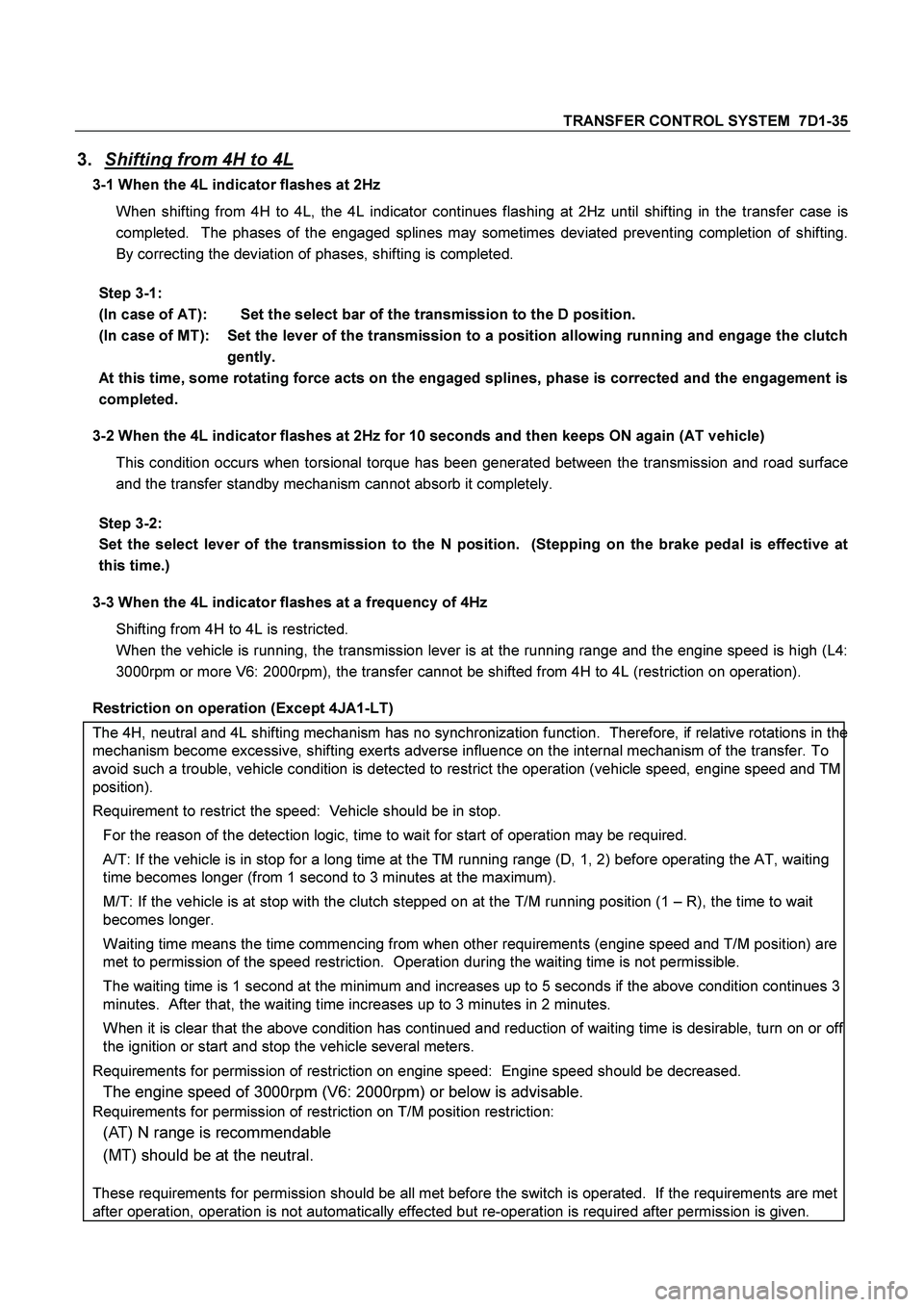
TRANSFER CONTROL SYSTEM 7D1-35
3.
Shifting from 4H to 4L
3-1 When the 4L indicator flashes at 2Hz
When shifting from 4H to 4L, the 4L indicator continues flashing at 2Hz until shifting in the transfer case is
completed. The phases of the engaged splines may sometimes deviated preventing completion of shifting.
By correcting the deviation of phases, shifting is completed.
Step 3-1:
(In case of AT): Set the select bar of the transmission to the D position.
(In case of MT): Set the lever of the transmission to a position allowing running and engage the clutch
gently.
At this time, some rotating force acts on the engaged splines, phase is corrected and the engagement is
completed.
3-2 When the 4L indicator flashes at 2Hz for 10 seconds and then keeps ON again (AT vehicle)
This condition occurs when torsional torque has been generated between the transmission and road surface
and the transfer standby mechanism cannot absorb it completely.
Step 3-2:
Set the select lever of the transmission to the N position. (Stepping on the brake pedal is effective at
this time.)
3-3 When the 4L indicator flashes at a frequency of 4Hz
Shifting from 4H to 4L is restricted.
When the vehicle is running, the transmission lever is at the running range and the engine speed is high (L4:
3000rpm or more V6: 2000rpm), the transfer cannot be shifted from 4H to 4L (restriction on operation).
Restriction on operation (Except 4JA1-LT)
The 4H, neutral and 4L shifting mechanism has no synchronization function. Therefore, if relative rotations in the
mechanism become excessive, shifting exerts adverse influence on the internal mechanism of the transfer. To
avoid such a trouble, vehicle condition is detected to restrict the operation (vehicle speed, engine speed and TM
position).
Requirement to restrict the speed: Vehicle should be in stop.
For the reason of the detection logic, time to wait for start of operation may be required.
A/T: If the vehicle is in stop for a long time at the TM running range (D, 1, 2) before operating the AT, waiting
time becomes longer (from 1 second to 3 minutes at the maximum).
M/T: If the vehicle is at stop with the clutch stepped on at the T/M running position (1 – R), the time to wait
becomes longer.
Waiting time means the time commencing from when other requirements (engine speed and T/M position) are
met to permission of the speed restriction. Operation during the waiting time is not permissible.
The waiting time is 1 second at the minimum and increases up to 5 seconds if the above condition continues 3
minutes. After that, the waiting time increases up to 3 minutes in 2 minutes.
When it is clear that the above condition has continued and reduction of waiting time is desirable, turn on or off
the ignition or start and stop the vehicle several meters.
Requirements for permission of restriction on engine speed: Engine speed should be decreased.
The engine speed of 3000rpm (V6: 2000rpm) or below is advisable.
Requirements for permission of restriction on T/M position restriction:
(AT) N range is recommendable
(MT) should be at the neutral.
These requirements for permission should be all met before the switch is operated. If the requirements are met
after operation, operation is not automatically effected but re-operation is required after permission is given.
Page 3662 of 4264
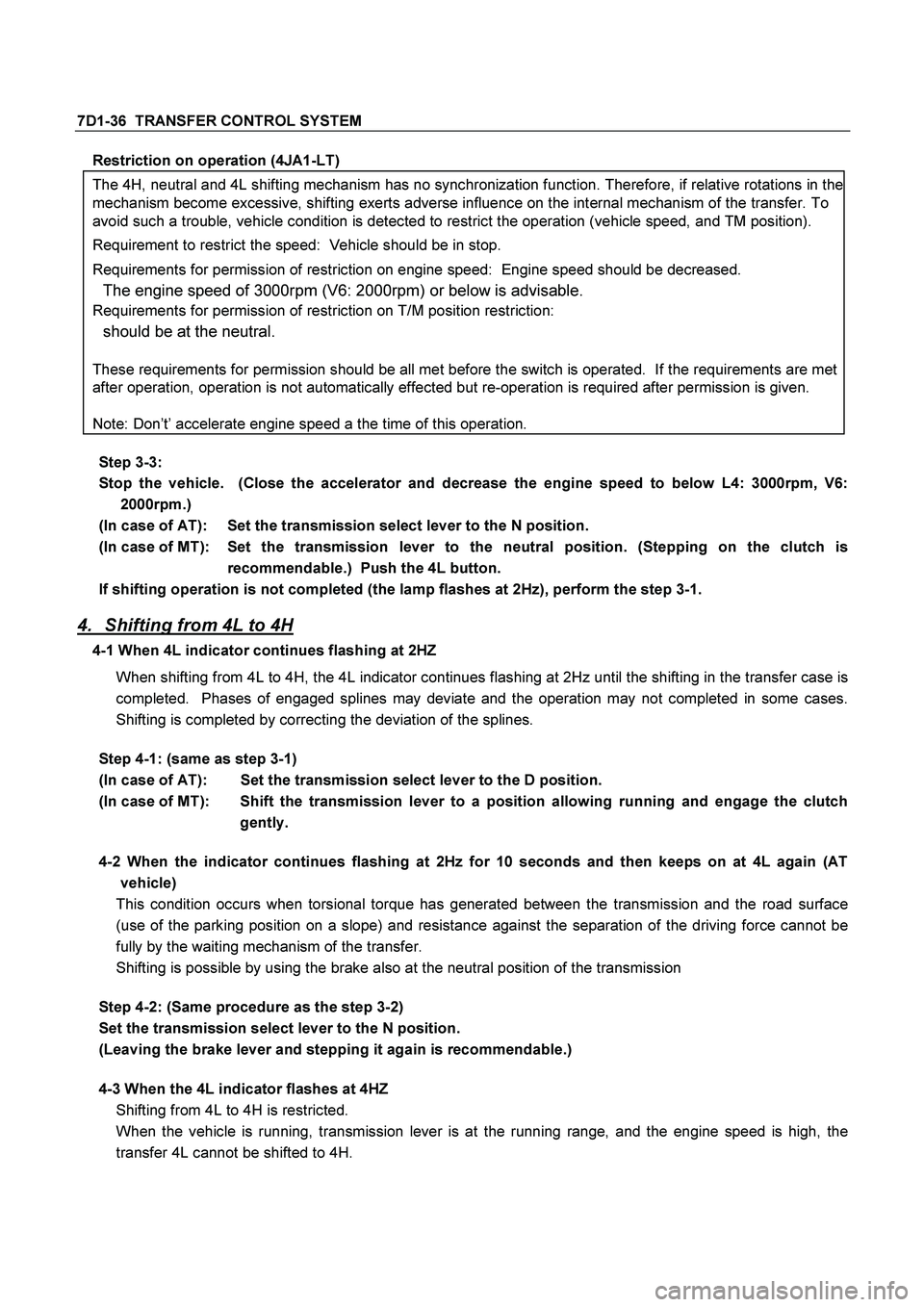
7D1-36 TRANSFER CONTROL SYSTEM
Restriction on operation (4JA1-LT)
The 4H, neutral and 4L shifting mechanism has no synchronization function. Therefore, if relative rotations in the
mechanism become excessive, shifting exerts adverse influence on the internal mechanism of the transfer. To
avoid such a trouble, vehicle condition is detected to restrict the operation (vehicle speed, and TM position).
Requirement to restrict the speed: Vehicle should be in stop.
Requirements for permission of restriction on engine speed: Engine speed should be decreased.
The engine speed of 3000rpm (V6: 2000rpm) or below is advisable.
Requirements for permission of restriction on T/M position restriction:
should be at the neutral.
These requirements for permission should be all met before the switch is operated. If the requirements are met
after operation, operation is not automatically effected but re-operation is required after permission is given.
Note: Don’t’ accelerate engine speed a the time of this operation.
Step 3-3:
Stop the vehicle. (Close the accelerator and decrease the engine speed to below L4: 3000rpm, V6:
2000rpm.)
(In case of AT): Set the transmission select lever to the N position.
(In case of MT): Set the transmission lever to the neutral position. (Stepping on the clutch is
recommendable.) Push the 4L button.
If shifting operation is not completed (the lamp flashes at 2Hz), perform the step 3-1.
4. Shifting from 4L to 4H
4-1 When 4L indicator continues flashing at 2HZ
When shifting from 4L to 4H, the 4L indicator continues flashing at 2Hz until the shifting in the transfer case is
completed. Phases of engaged splines may deviate and the operation may not completed in some cases.
Shifting is completed by correcting the deviation of the splines.
Step 4-1: (same as step 3-1)
(In case of AT): Set the transmission select lever to the D position.
(In case of MT): Shift the transmission lever to a position allowing running and engage the clutch
gently.
4-2 When the indicator continues flashing at 2Hz for 10 seconds and then keeps on at 4L again (AT
vehicle)
This condition occurs when torsional torque has generated between the transmission and the road surface
(use of the parking position on a slope) and resistance against the separation of the driving force cannot be
fully by the waiting mechanism of the transfer.
Shifting is possible by using the brake also at the neutral position of the transmission
Step 4-2: (Same procedure
as the step 3-2)
Set the transmission select lever to the N position.
(Leaving the brake lever and stepping it again is recommendable.)
4-3 When the 4L indicator flashes at 4HZ
Shifting from 4L to 4H is restricted.
When the vehicle is running, transmission lever is at the running range, and the engine speed is high, the
transfer 4L cannot be shifted to 4H.
Page 3665 of 4264
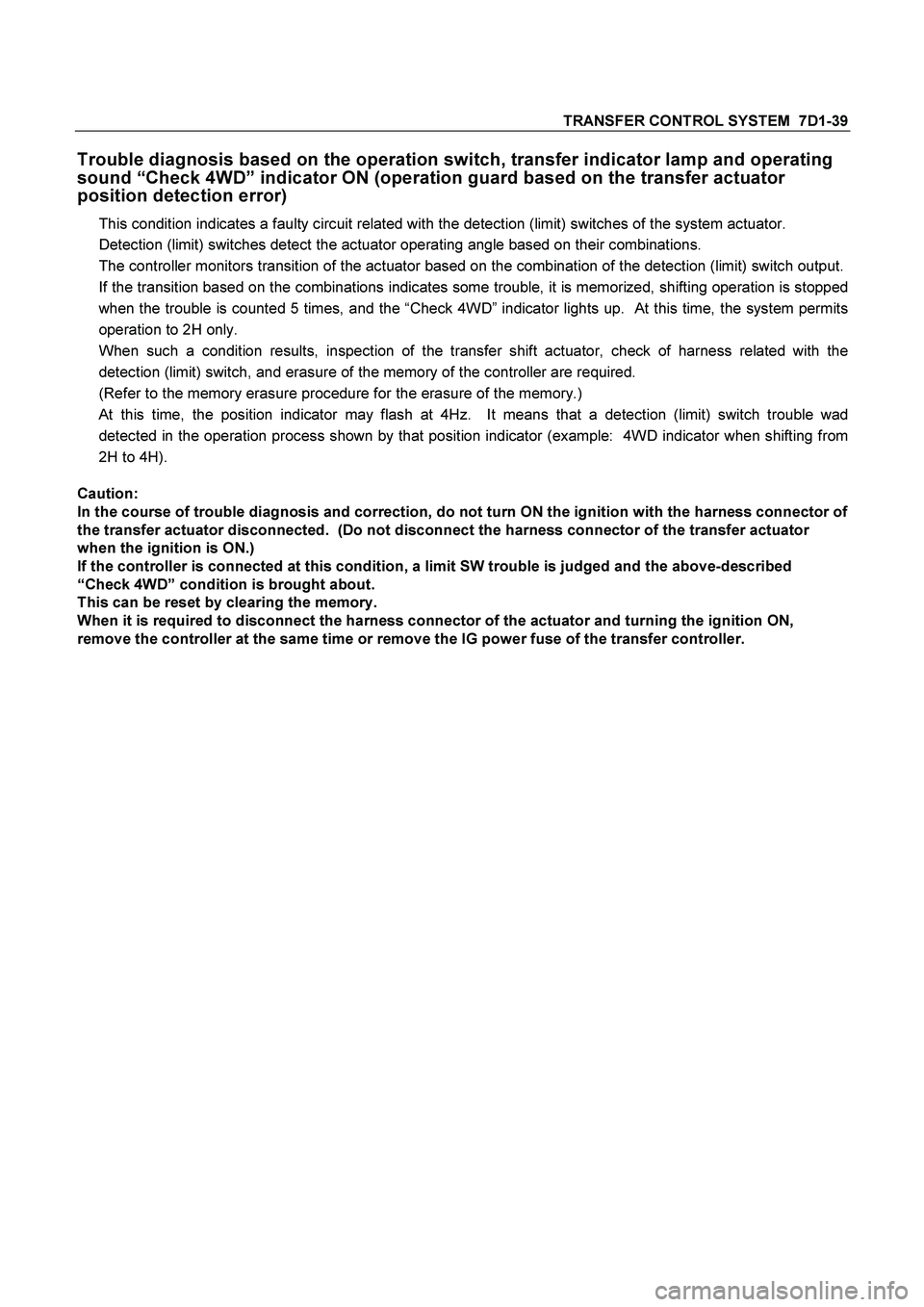
TRANSFER CONTROL SYSTEM 7D1-39
Trouble diagnosis based on the operation switch, transfer indicator lamp and operating
sound “Check 4WD” indicator ON (operation guard based on the transfer actuator
position detection error)
This condition indicates a faulty circuit related with the detection (limit) switches of the system actuator.
Detection (limit) switches detect the actuator operating angle based on their combinations.
The controller monitors transition of the actuator based on the combination of the detection (limit) switch output.
If the transition based on the combinations indicates some trouble, it is memorized, shifting operation is stopped
when the trouble is counted 5 times, and the “Check 4WD” indicator lights up. At this time, the system permits
operation to 2H only.
When such a condition results, inspection of the transfer shift actuator, check of harness related with the
detection (limit) switch, and erasure of the memory of the controller are required.
(Refer to the memory erasure procedure for the erasure of the memory.)
At this time, the position indicator may flash at 4Hz. It means that a detection (limit) switch trouble wad
detected in the operation process shown by that position indicator (example: 4WD indicator when shifting from
2H to 4H).
Caution:
In the course of trouble diagnosis and correction, do not turn ON the ignition with the harness connector of
the transfer actuator disconnected. (Do not disconnect the harness connector of the transfer actuator
when the ignition is ON.)
If the controller is connected at this condition, a limit SW trouble is judged and the above-described
“Check 4WD” condition is brought about.
This can be reset by clearing the memory.
When it is required to disconnect the harness connector of the actuator and turning the ignition ON,
remove the controller at the same time or remove the IG power fuse of the transfer controller.
Page 3667 of 4264
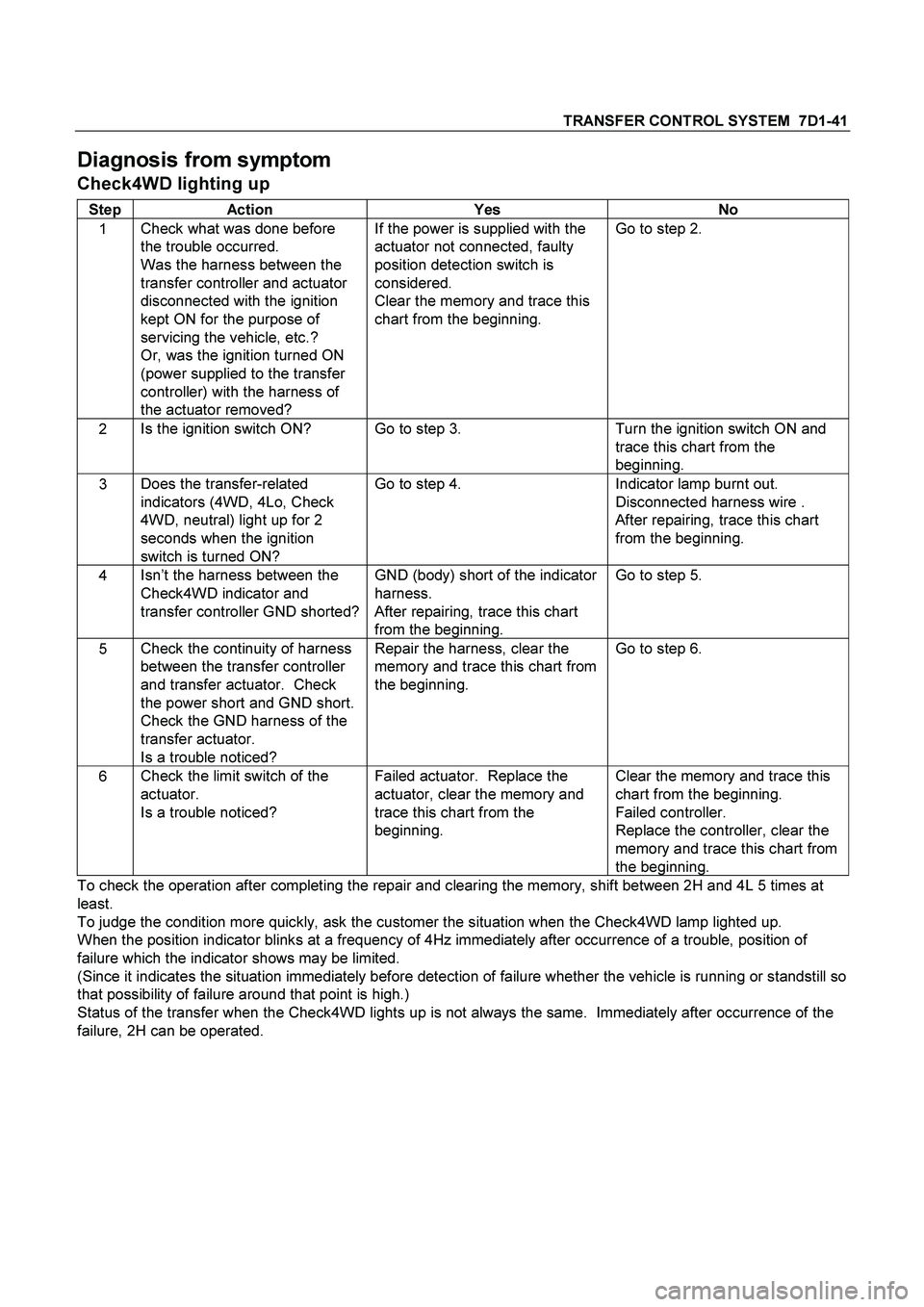
TRANSFER CONTROL SYSTEM 7D1-41
Diagnosis from symptom
Check4WD lighting up
Step Action Yes No
1 Check what was done before
the trouble occurred.
Was the harness between the
transfer controller and actuator
disconnected with the ignition
kept ON for the purpose of
servicing the vehicle, etc.?
Or, was the ignition turned ON
(power supplied to the transfer
controller) with the harness of
the actuator removed? If the power is supplied with the
actuator not connected, faulty
position detection switch is
considered.
Clear the memory and trace this
chart from the beginning. Go to step 2.
2 Is the ignition switch ON? Go to step 3. Turn the ignition switch ON and
trace this chart from the
beginning.
3 Does the transfer-related
indicators (4WD, 4Lo, Check
4WD, neutral) light up for 2
seconds when the ignition
switch is turned ON? Go to step 4. Indicator lamp burnt out.
Disconnected harness wire .
After repairing, trace this chart
from the beginning.
4 Isn’t the harness between the
Check4WD indicator and
transfer controller GND shorted? GND (body) short of the indicator
harness.
After repairing, trace this chart
from the beginning. Go to step 5.
5 Check the continuity of harness
between the transfer controller
and transfer actuator. Check
the power short and GND short.
Check the GND harness of the
transfer actuator.
Is a trouble noticed? Repair the harness, clear the
memory and trace this chart from
the beginning. Go to step 6.
6 Check the limit switch of the
actuator.
Is a trouble noticed? Failed actuator. Replace the
actuator, clear the memory and
trace this chart from the
beginning. Clear the memory and trace this
chart from the beginning.
Failed controller.
Replace the controller, clear the
memory and trace this chart from
the beginning.
To check the operation after completing the repair and clearing the memory, shift between 2H and 4L 5 times at
least.
To judge the condition more quickly, ask the customer the situation when the Check4WD lamp lighted up.
When the position indicator blinks at a frequency of 4Hz immediately after occurrence of a trouble, position of
failure which the indicator shows may be limited.
(Since it indicates the situation immediately before detection of failure whether the vehicle is running or standstill so
that possibility of failure around that point is high.)
Status of the transfer when the Check4WD lights up is not always the same. Immediately after occurrence of the
failure, 2H can be operated.
Page 3668 of 4264

7D1-42 TRANSFER CONTROL SYSTEM
Cannot shift from 2WD to 4H or 4L.
When shifting from 2H to other position, the indicator (4WD, 4Lo, Check4WD, neutral)
does not respond.
Step Action Yes No
1 Is the ignition switch ON? Go to step 2. Turn the ignition switch ON and
trace this chart from the
beginning.
2 Does the transfer-related
indicators (4WD, 4Lo, Check
4WD, neutral) light up for 2
seconds when the ignition
switch is turned ON? Failed operation switch. Only 2H
is stuck at ON condition and 4H-
4L position is internally
disconnected. Or,
Failed controller Indicator lamp burnt out.
Disconnected harness wire .
After repairing, trace this chart
from the beginning.
Even after correction step 1-1(*), 4WD indicator blinks at 4Hz and changes to 2H after 10
seconds.
Step Action Yes No
1 Is the ignition switch ON? Go to step 2. Turn the ignition switch ON and
trace this chart from the
beginning.
2 Does the transfer-related
indicators (4WD, 4Lo, Check
4WD, neutral) light up for 2
seconds when the ignition
switch is turned ON? Go to step 3. Indicator lamp burnt out.
Disconnected harness wire.
After repairing, trace this chart
from the beginning.
3 After 2 seconds, check that the
Check4WD lamp is ON or OFF.
Is the Check4WD lamp OFF? Go to step 4. Failed actuator position detection
switch (LS1, LS2, LS3, LS4,
GND).
Short or disconnection of harness
of this detection switch.
After repairing, trace this chart
from the beginning.
4 Press the 4H button.
Is sound of relay heard from the
transfer control? Go to step 5. Failed controller.
Replace the controller and trace
this chart from the beginning.
5 Is the sound of running motor
heard? Failed control system of the
transfer mechanism. Check and
repair and trace this chart from
the beginning. Failed actuator motor.
Disconnected controller motor
drive output circuit, GND short
circuit. +B fuse blown out.
Disconnection of that harness.
After repairing, trace this chart
from the beginning.
*Before determining a trouble (Non-trouble mode)
Page 3669 of 4264

TRANSFER CONTROL SYSTEM 7D1-43
Even after the correction step 1-2(*), the 4WD indicator still blinks at 2Hz when shifting
from 2H to 4H.
Step Action Yes No
1 Check the air pressure and wear
of all the tires. Is any trouble
noticed? After adjusting the air pressure
and repairing the tire worn away,
try the correction step 1-2(*). Go to step 2.
2 Check the 4WD detection switch
on the transfer case, neutral
detection switch and each
harness. Is a trouble noticed? 4WD detection switch is open or
the harness failed.
The neutral detection switch is
closed or the harness GND is
shorted.
Replace or repair and then trace
this chart from the beginning. Go to step 3.
3 Is there continuity in the harness
between the transfer controller
and front axle actuator? Isn’t a
body short or disconnection
noticed? Go to step 4. Body short or disconnection of
the harness between the transfer
controller and front axle actuator.
After repairing, trace this chart
from the beginning.
4 Is a trouble noticed in the axle
detection harness between the
axle actuator and transfer
controller? Disconnected harness.
After repairing trace this chart
from the beginning. Malfunction of axle actuator.
Refer to the paragraph of the
axle disconnect.
After repairing, trace this chart
from the beginning.
*Before determining a trouble (Non-trouble mode)
Note:
The vehicle of manual hub and rigid hub don’t have axle actuator.
When the above-mentioned procedure is followed, check the harness between the axle dummy output terminal and
the axle switch input terminal of transfer controller instead of axle actuator.
Page 3671 of 4264
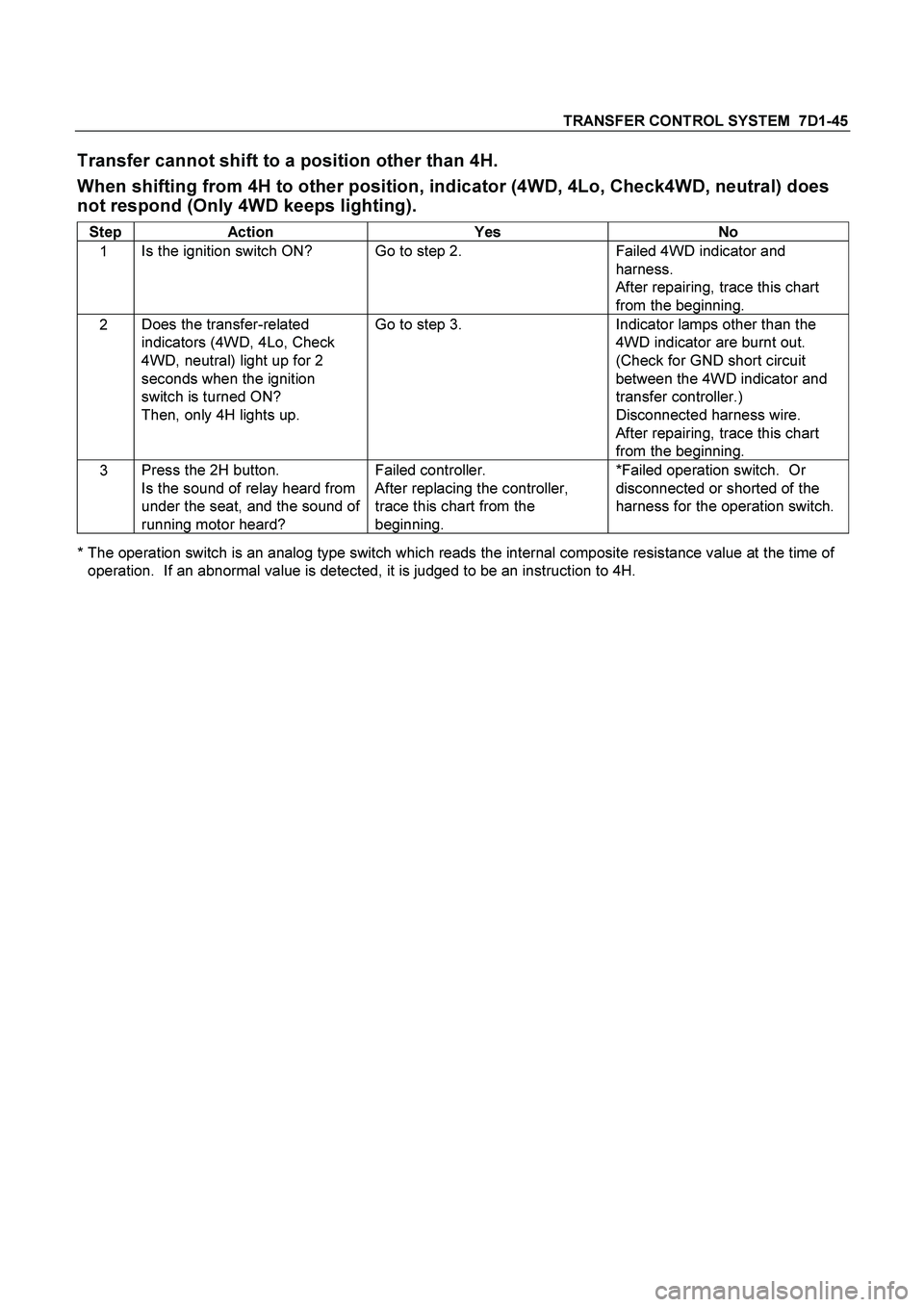
TRANSFER CONTROL SYSTEM 7D1-45
Transfer cannot shift to a position other than 4H.
When shifting from 4H to other position, indicator (4WD, 4Lo, Check4WD, neutral) does
not respond (Only 4WD keeps lighting).
Step Action Yes No
1 Is the ignition switch ON? Go to step 2. Failed 4WD indicator and
harness.
After repairing, trace this chart
from the beginning.
2 Does the transfer-related
indicators (4WD, 4Lo, Check
4WD, neutral) light up for 2
seconds when the ignition
switch is turned ON?
Then, only 4H lights up. Go to step 3. Indicator lamps other than the
4WD indicator are burnt out.
(Check for GND short circuit
between the 4WD indicator and
transfer controller.)
Disconnected harness wire.
After repairing, trace this chart
from the beginning.
3 Press the 2H button.
Is the sound of relay heard from
under the seat, and the sound of
running motor heard? Failed controller.
After replacing the controller,
trace this chart from the
beginning. *Failed operation switch. Or
disconnected or shorted of the
harness for the operation switch.
* The operation switch is an analog type switch which reads the internal composite resistance value at the time of
operation. If an abnormal value is detected, it is judged to be an instruction to 4H.
Page 3672 of 4264
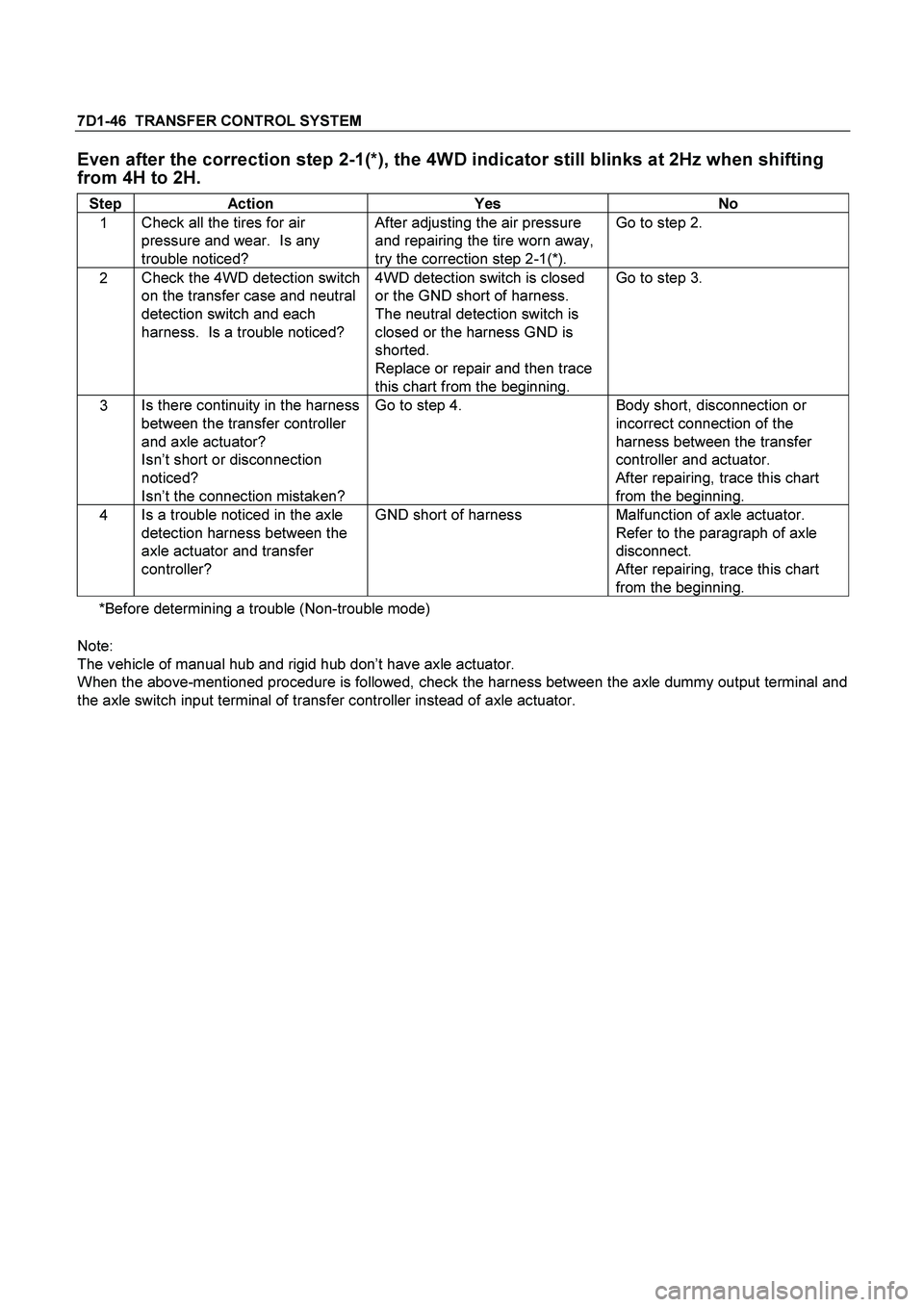
7D1-46 TRANSFER CONTROL SYSTEM
Even after the correction step 2-1(*), the 4WD indicator still blinks at 2Hz when shifting
from 4H to 2H.
Step Action Yes No
1 Check all the tires for air
pressure and wear. Is any
trouble noticed? After adjusting the air pressure
and repairing the tire worn away,
try the correction step 2-1(*). Go to step 2.
2 Check the 4WD detection switch
on the transfer case and neutral
detection switch and each
harness. Is a trouble noticed? 4WD detection switch is closed
or the GND short of harness.
The neutral detection switch is
closed or the harness GND is
shorted.
Replace or repair and then trace
this chart from the beginning. Go to step 3.
3 Is there continuity in the harness
between the transfer controller
and axle actuator?
Isn’t short or disconnection
noticed?
Isn’t the connection mistaken? Go to step 4. Body short, disconnection or
incorrect connection of the
harness between the transfer
controller and actuator.
After repairing, trace this chart
from the beginning.
4 Is a trouble noticed in the axle
detection harness between the
axle actuator and transfer
controller? GND short of harness Malfunction of axle actuator.
Refer to the paragraph of axle
disconnect.
After repairing, trace this chart
from the beginning.
*Before determining a trouble (Non-trouble mode)
Note:
The vehicle of manual hub and rigid hub don’t have axle actuator.
When the above-mentioned procedure is followed, check the harness between the axle dummy output terminal and
the axle switch input terminal of transfer controller instead of axle actuator.